In the Studio: Christian Việt Đinh
“My nail salon series is meant to celebrate the success of the Vietnamese nail s...

Margaret Curtis is an artist based in North Carolina and a 2021 recipient of the Joan Mitchell Fellowship. We interviewed her about her work and studio processes in June 2022. The following is an edited transcript of that conversation.
My work is about power, which is a very broad term. I'm really interested in how power relationships on the interpersonal level correspond to power dynamics within the larger societal framework. I think of myself as a feminist artist, and at its core, feminism is the idea that the personal is political. It's ultimately about who wields power, how that power is hidden or expressed, and about working towards power sharing and greater equity across all genders, abilities, races—everything. And of course, those power dynamics have everything to do with what is happening around us right now environmentally.
I'm drawn to images that have a certain history—somewhere between iconic, trite, and corny—imagery that has spent enough time out in the world to have accumulated multiple or conflicting layers of meaning, or where the messaging has worn down, shifted, or fallen apart in some way. I like teasing that apart, playing with the contradictions and shifts. I'm tinkering with cultural gas lighting, what we see on the surface versus what’s quietly working away inside, between seeming and being, groping around in that gap, trying to come up with something that's more direct.
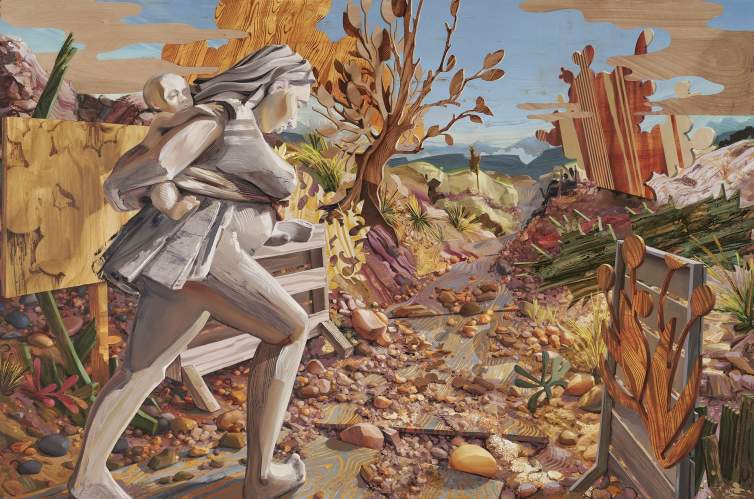
Most of the imagery in my paintings is the product of long periods of reflection—of sketching, dragging sketches and folders of found imagery into and out of photoshop, printing that, drawing on the print, and feeding that back into photoshop, etc . When I lived in New York, pre-internet, I’d trek to the picture files in the Mid-Manhattan Library and do the same hunting and foraging, but analog. I take sketchbooks with me everywhere. They're journals of drawings, responses, text. Prolonged meditations, in a way. I work on several at a time, because the sketchbooks themselves tend to take on different personalities, and certain trains of thought or drawings are better suited to certain journals.
So by the time I start a painting, there's a lot of thought that's gone into the imagery I'm going to use, the dissonances in meaning I’ll be processing, and the overall tone or personality that might best convey the content. Of course, all of that intention gets thrown in the air once I get into the painting. I really love how the process of painting takes over. There are always so many unforeseen issues and problems to solve, and the paintings always surpass the idea and prep work I started with. I’m not a big believer in style.
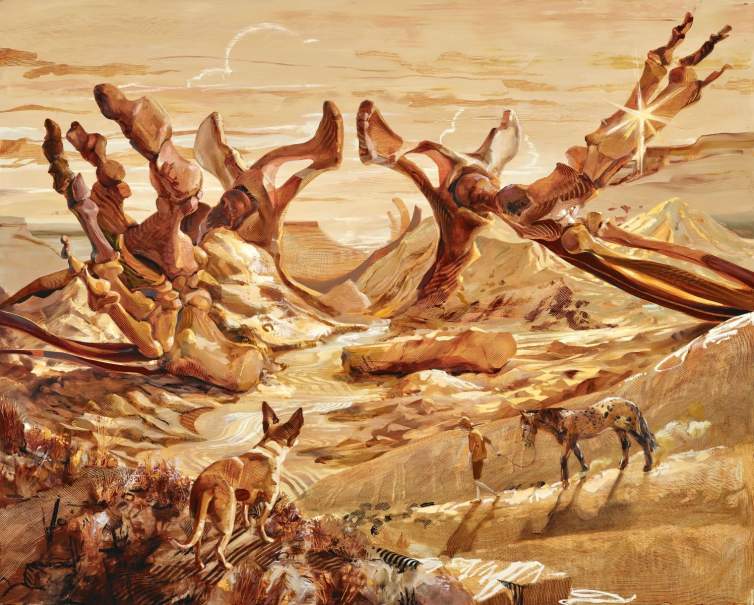
Sometimes imagery originates as a sentence or phrase that turns over in my mind like an ear worm. Giving visual form to an aphorism like that is intriguing to me. I Wandered the Mesas of My Mother’s Bones started as its title, really. There are visual puns in the work, too: rocky roads, smoking guns.
Rarely, images blaze up or flash in my head fully formed, right down to color, like the orange pink streak under the burlap bag of the hunter inAmerican Family of Four. These are the paintings I prioritize. I go in immediately and try to be as loyal to the mental image as I can, while it’s fresh. These paintings tend to come up very fast. Portrait of My Anxiety is an example of that, as is American Family of Four. Thinking about those paintings in particular…they have a dark fairy tale quality, which is something for me to think more about.
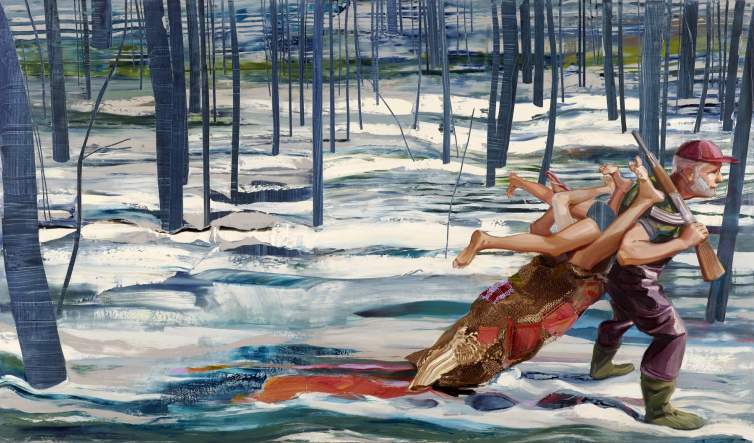
I’ve always been interested in the substance of paint—its plastic, clay-like qualities—and how that physicality coexists with line. It's really important to me that the surface of my paintings contain a history of the sloppy process of bringing them up—that there be a palpable, embodied sense of time visible in the accumulation and subtraction of paint in the final image. That the movement of my hand be visible to the viewer. That’s an aspect of the work which is hard to appreciate in digital reproduction.
If you ran a thumbnail over the surface of my work, it’d get caught and snagged on the blobs and layers. Sometimes I use cake decorating tools for very thick, extruded passages of paint, which can sit a half inch high off the surface. Sometimes rubber stamps that I’ve carved. The stamps can lay a crisp line on top of a rough, ruptured surface. I like that edge. Sometimes it's the thinnest translucent underpainting that's masked off and still visible at the end. Lately, I’ve been masking off and incorporating the wooden panel itself. The changes in the surface create a lot of visual, graphic tension.
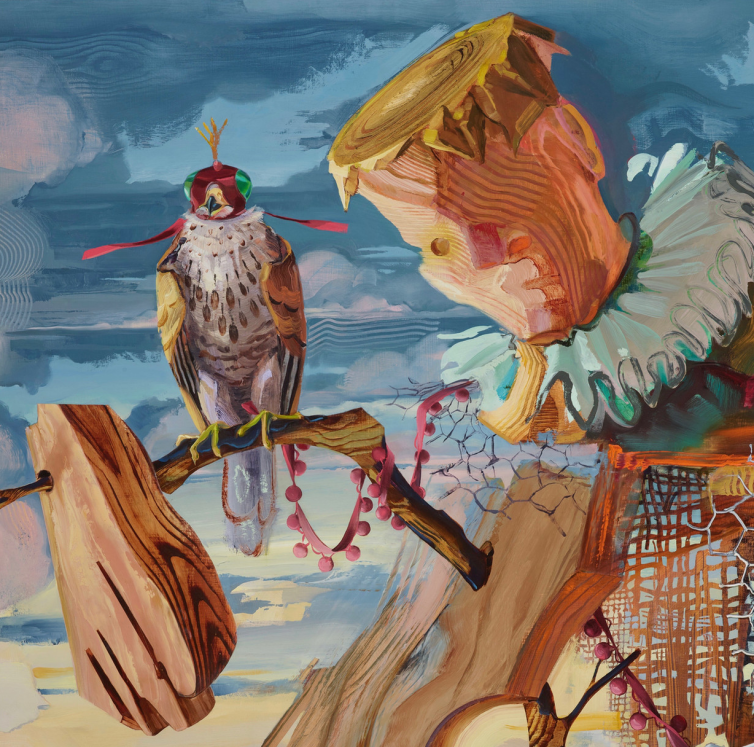
My brush work is pretty simple and hamfisted. There's not a lot of blending or mystifying technique. I’m more interested in how loose (or what I think of as “dumb” or obvious) marks start to layer and lock together and build into something more specific. It's engrossing—embedding subject matter and abstract content in this physical substance—when everything opens up and is on the table again for reconsideration and heavy edits. There’s a lot of anxious problem solving to fit it all together. That’s the fun and maddening part, where an artist is on her toes. It’s deeply challenging and satisfying.
My use of color is also very intentional. I grew up in Tennessee. My father was a gemologist. We would load up the station wagon with all of his cut gemstones and mineral specimens and do these roadside gem shows throughout the rural Southeast. Or comb the hillside tailings of old talcum mines searching for garnets and fossils. The minerals I loved the most were the semi-precious stones like malachite, tiger's eye, and landscape agate, which have such a vibrant sense of light and space that form when translucent veins of color snake through and intrude into dense opaque color fields, and vice versa.
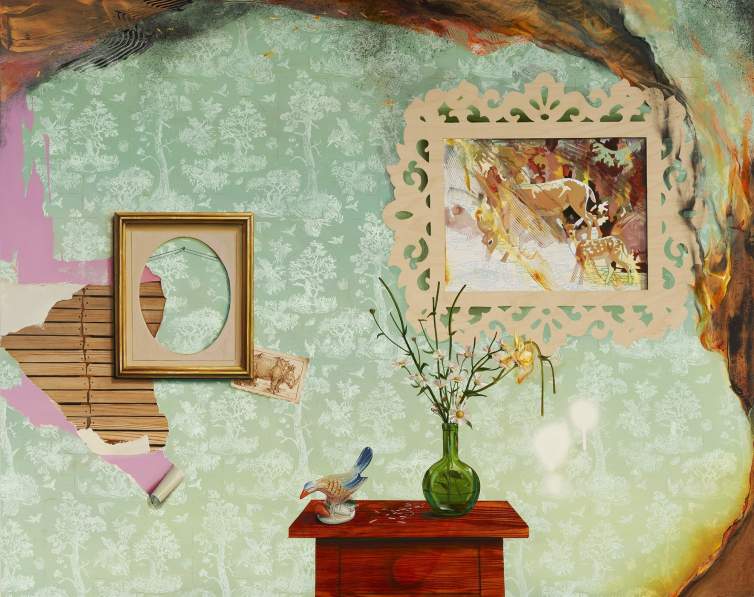
My dad had a windowsill in his office covered in test tubes of opals suspended in liquid. Holding and turning something as geologically complex and full of fire and light as those mineral specimens was wonderous to me—handheld nuggets of eons of time and movement. I think that had a huge effect on what I want from the physical aspect of my work. I want the paintings to have a body, a somatic reality, a sense of time in how they are physically built and perceived.
Color wise, I've always worked with this interplay between translucent passages of color—which could be anything from a washy underpainting to glazes to transparent pigments—and areas of opacity. I build luminosity that way. There’s a lot of movement and slippage in transparent color. Opaque areas stop or channel or contain that movement. For me, that has everything to do with a sense of geological time and accumulation.
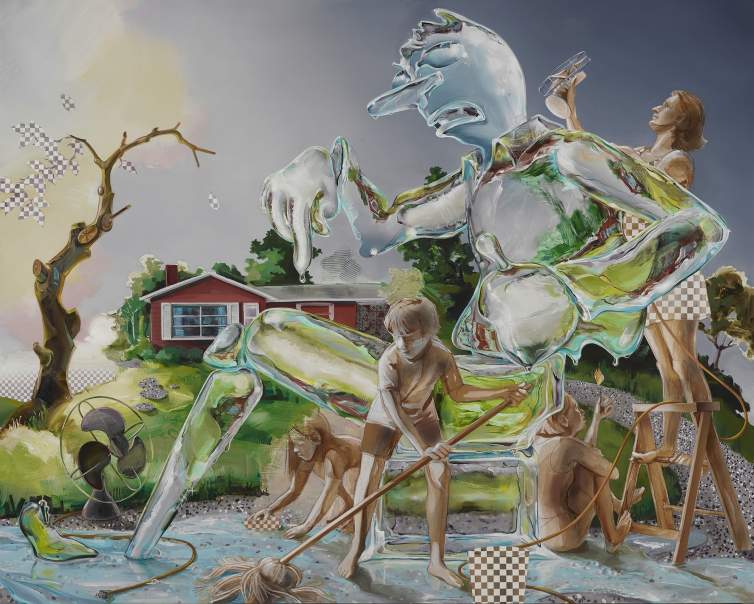
The Ice Sculpture is a fun painting to talk about in terms of process. I knew I wanted to do an image of a narcissistic persona as an ice sculpture for a long time. But it took the Trump years to really solidify the form that would take.
There's a power dynamic that’s common in families of highly narcissistic individuals. You have the narcissist, of course, and the inverts or enablers, who take on all the aspects the narcissist can’t bear in himself, like the fear, depression, insecurity and self doubt. Children are pitted against each other and placed into very specific roles, like scapegoat or golden child. We saw this play out on the societal level with Trump. He was this raging but fragile ego, surrounded by enablers and apologists who were totally incapable of standing up to him and ran around trying to manage his meltdowns, like the woman in the painting fanning the monster to keep him from literally melting. And the groups he scapegoated, like immigrants, women, and people of color, versus the people he pandered to like evangelicals and white supremacists. That dynamic was very similar on the micro and macro level.
So yes, I had wanted to paint an ice sculpture for a long time. I was looking at Baroque paintings of the Deposition for vertical compositions with multiple figures spiraling around a central form. And I was looking at photos of outdoor ice sculpture competitions, where the landscape could be seen through the ice. But I was having a hard time getting my head around exactly how those distant objects were being refracted through the ice, what exactly was happening. Reflections can be really counterintuitive. So I decided to make a quick ice sculpture for reference. I filled Playtex gloves with water and froze them. I filled a large balloon with water, froze it, and sculpted out eyes, added a nose, and so on, with a small kitchen blowtorch. I realized I could get the same refraction effect if I filled clear plastic bottles with water. So I ended up cobbling together this monster out of ice parts and soda bottles.
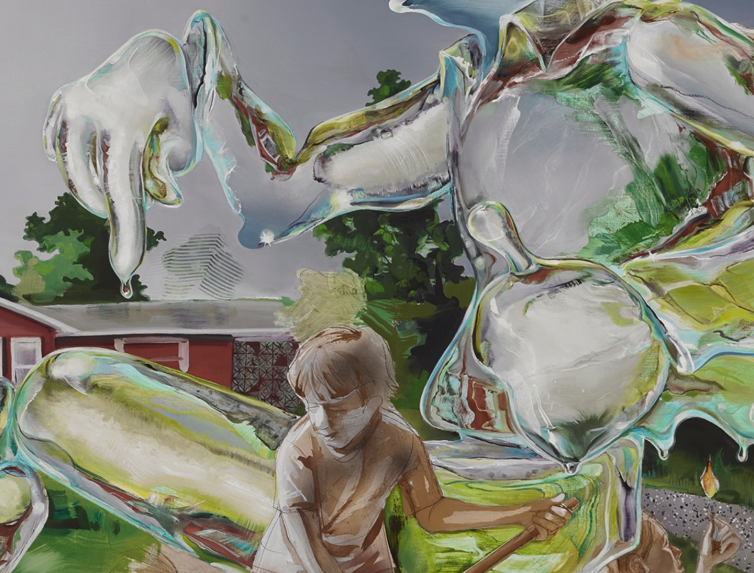
This was in late September and it was really hot. I made a simple backdrop in my driveway with a blanket and a red construction paper ranch house (like the one I grew up in) and some cut branches from my yard. When I brought out the ice and soda bottle monster, it started melting and falling apart immediately. So I was frantically taking these photos and at the same time, I was blown away by how the red house was reflected throughout the sculpture, how each body part or bulge or curve became a new lens which distorted the house again, and in a different way. It was reflected over and over and over again—throughout the hands, like along each finger, and the face, all throughout the sculpture—always upside down and mirror–image, and highly distorted.
That, for me, became the visual metaphor I would go with—how the home in that painting is distorted over and over and over again by this monstrous ego, and how he proudly wears that distortion like a bad suit. He’s this slick, seductive surface, something that can be easily rendered in oil. In contrast, the figures around him are drawn in pencil and ink on a matte watercolor ground. There’s something so immediate and human about drawing. It retains a history of the artist’s search for, the groping around for form, of imperfections and mistakes. Drawing the other family members made them seem more real and relatable by separating them out, visually, from all the illusionism of the monster. Those visual metaphors were something I couldn't have imagined ahead of time. That came through the process of trying to understand light and realize a complicated image, and giving myself the info I needed.
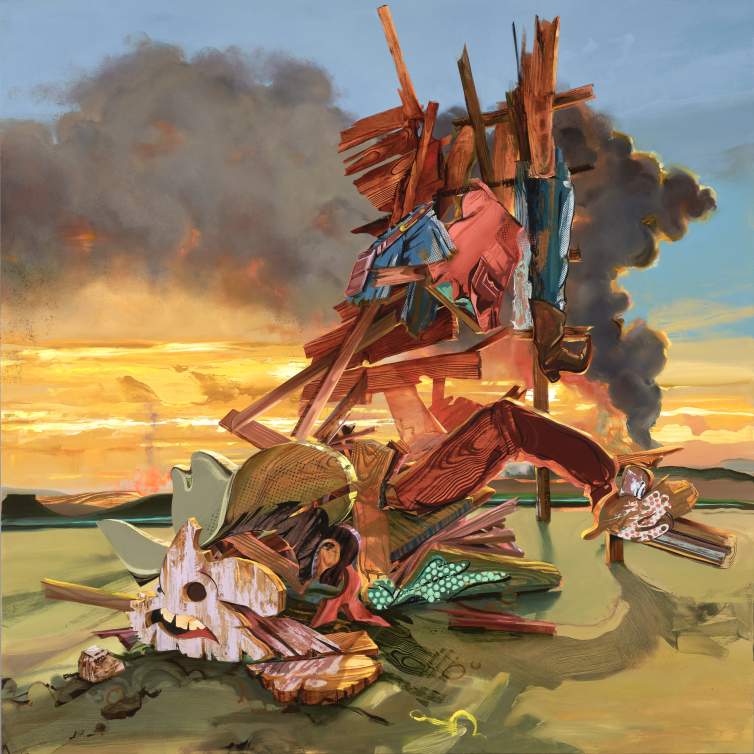
Currently, I'm starting a body of work that deals with the idea of signage, which is a subject I’ve explored in the past. I drive a lot, long drives, out to New Mexico and back, which is 1,500 miles one way. You see signs along the roadside in various stages of decay, and they become an integral part of the landscape. They have history, both in their imagery and as weathered objects in the world. People put up signs because they're trying to sell you something or lure you somewhere. I'm interested in what's actually being sold by our culture and how that relates to the sales pitches, the manipulations in that.
I’m thinking a lot about this idea of “innocence” that has always infected American culture but has reached a point of hysteria recently, to the point that people are afraid to even acknowledge a history they already know, and a system of discrimination and systemic inequality which, of course, they are well aware of too, while desperately proclaiming their freedom from a cultural heritage they idolize. I guess I’m playing with how a white dominated culture markets whiteness. And how innocence is embedded in this subtle and sly culture of menace I see all around me. So the broken and rotting wooden billboard structures and the disintegrating sign imagery become metaphors for anachronistic and outdated systems and a lack of integrity in how we see ourselves. I’m still turning this over in my head. I hope I can play with all that in a way that is a little bit more honest or relevant to what’s happening now.
In the painting I just finished, Sun Sets on the Shitkicker, I created a miniature billboard of a cowboy— the quintessential gun-toting, rugged individualist—out of wood. I broke it, toppled it, and photographed it against a strong backlight. That gave me a lot of information to work with. The image of the shit kicker was a combination of photographs I had taken on the road of muffler men and steakhouse billboards and of my own drawings. When I started the piece, New Mexico was experiencing its biggest wildfire ever—actually, it still is burning, four months later. The burn plume from that wildfire rises from his gun and dominates the background, although it's certainly not necessary for the viewer to know that.
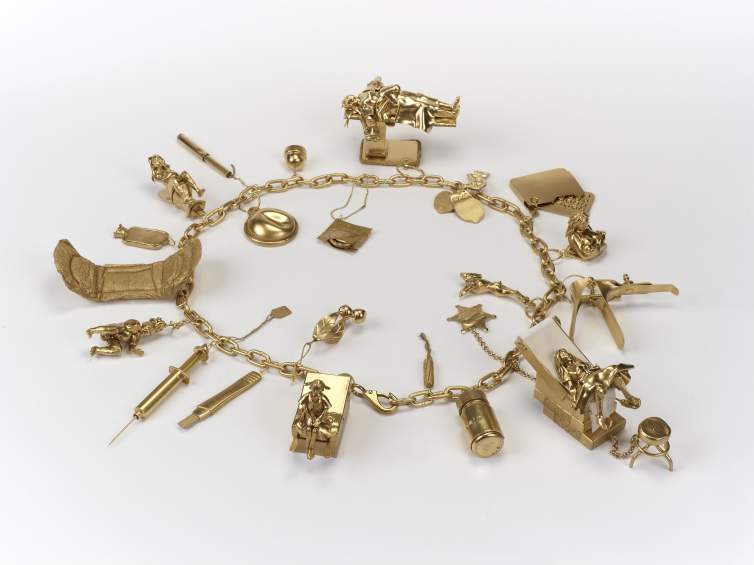
Today, when we’re speaking, is the day that the Supreme Court overturned Roe v. Wade. I guess we all knew this was coming, but it still is such a kick in the gut. I don't recognize this country anymore. I’ve been thinking about my piece, Charm Bracelet of My Reproductive Career, which I made when COVID first hit and the nation was in lockdown. I was stuck at home, all my plans on hold. A friend on Facebook had posted about how tired she was of feeling hobbled by perimenopause and a reproductive system that, as a lesbian who had never wanted kids, was simply a burden. The post opened up this really honest and frank thread from dozens of women about the realities of living with a female reproductive system, and the interface of that with modern medicine.
As somebody who has given birth twice later in life and had, as every person with a uterus does, a very long history with reproductive issues, I was thinking about the difference between what girls and young women are told, even by other women, and what actually happens. Again, the difference between what you are sold and what is. My son had a lot of oven-bake clay lying around the house and I started playing with it. I had never worked in sculpture or installation before, but quarantine opened up a very free space for me. I tried to make the piece reflect as much of the complexity as I could. It starts with your first period, your first pelvic exam, and goes up through menopause. I tried to make it inclusive—whether people had children or not, whether they identified as female or not—with at least a couple of charms anyone could relate to. I have personally experienced some of what is depicted, but not everything.
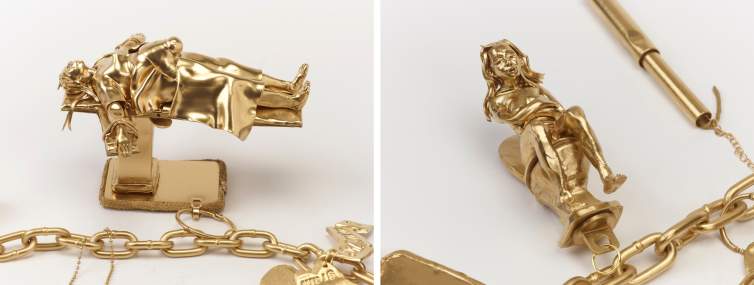
There’s a lot of romanticization around pregnancy and birth and tremendous silence around the downsides and suffering of managing a body capable of those things. And that is really unhelpful to everyone, and especially harmful to people who decide to give birth. Even women who are very progressive and open are often quiet around the realities of miscarriage, menopause, and what happens during pregnancy, birth, and nursing. There’s just so much there. To a certain extent I understand why. It’s private, and these things are happening inside of your own body. And things go wrong, a lot. Plus, when we do speak honestly, it’s used against us as some sort of proof of our “otherness” or unfitness relative to males. But the silence is harmful. Women feel like they're alone or that they’ve failed when everything goes off the rails. And especially with respect to healthcare, there’s not enough research. Scientists still don’t even know what initiates the process of labor and birth. That blows my mind. Women are still not included in studies and trials at an equal rate, and our pain is ignored or vastly undertreated relative to males.
This piece was recently at The Mint Museum in Charlotte, and I was listening to people respond to it during the opening. There was a guy there who went pale when he saw the speculum. “What is THAT!?” The women there laughed and explained what it was, and he was so shocked. A speculum is nothing! But people with zero understanding of our healthcare realities and needs feel they have an equal say in what we can or can’t do. And the really scary thing is that they do. In fact, they now have more of a say than we do.
Interview and editing by Jenny Gill. Learn more about Curtis’s work at margaretcurtisart.com.